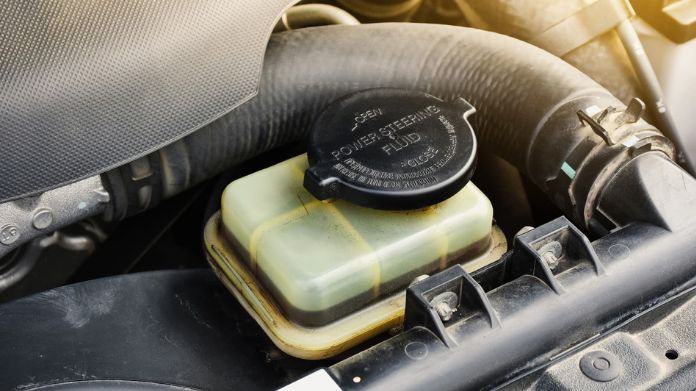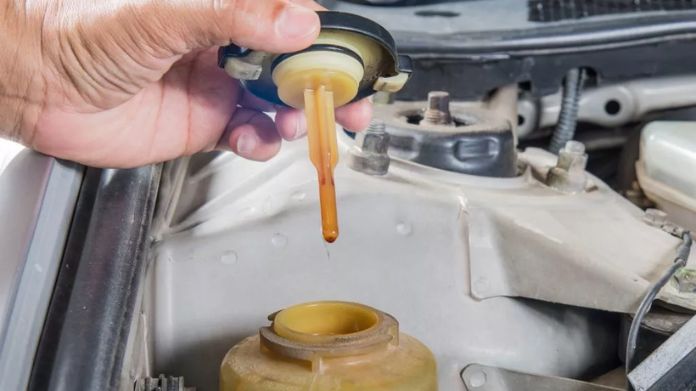If you’ve ever been behind the wheel and suddenly felt like turning the steering wheel took more effort than usual, chances are your power steering fluid is trying to tell you something.
This is one of those car fluids that don’t get talked about much, engine oil being the big one, but it sure works itself in the background to keep steering smooth and effortless.
Think of it this way, just as your body needs blood to keep everything moving, your car’s steering system needs power steering fluid to keep things flowing.
Over time, that fluid becomes dirty, stops functioning as efficiently, and causes your driving to be harder than it should be.
Thus, it’s so important to know how to change power steering fluid. And guess what? With a little prep, you can do it right in your driveway at no hassle.
Table of Contents
How to Change Power Steering Fluid: Step by Step
Step 1: Prepare Before You Change Power Steering Fluid
 Before diving in, let’s talk tools. You’ll need a few basics: a jack or lift, gloves, a drain pan, a funnel, and something to suck out the old fluid, like a syringe or even a turkey baster (yes, the same one usually reserved for Thanksgiving).
Before diving in, let’s talk tools. You’ll need a few basics: a jack or lift, gloves, a drain pan, a funnel, and something to suck out the old fluid, like a syringe or even a turkey baster (yes, the same one usually reserved for Thanksgiving).
Of course, don’t forget to check the new power steering fluid. Check your owner’s manual for the right type, because using the wrong one can cause serious issues.
Gloves aren’t just for keeping your hands clean, they protect your skin from chemicals. Always have your car sat over jack stands before crawling below it.
Just think of this step as setting the stage for the smooth work without stress.
Step 2: Drain the Old Fluid Safely
 This is the part where most people get a little nervous, but it’s not too bad. Start by using your syringe or turkey baster to remove as much old fluid as you can from the reservoir. Next, disconnect the return hose and let the rest drain into your pan.
This is the part where most people get a little nervous, but it’s not too bad. Start by using your syringe or turkey baster to remove as much old fluid as you can from the reservoir. Next, disconnect the return hose and let the rest drain into your pan.
Here’s a pro tip: turn your steering wheel from lock to lock (all the way left, then all the way right) while the ignition is in accessory mode.
This forces out more of the old fluid hiding in the system. Just remember it can get messy, so don’t rush, and definitely don’t let it spill on your driveway.
Step 3: Refill and Bleed the System
 That part is actually pretty satisfying; pouring in the fresh fluid. Put your funnel in the reservoir and then pour in the new fluid slowly.
That part is actually pretty satisfying; pouring in the fresh fluid. Put your funnel in the reservoir and then pour in the new fluid slowly.
Don’t dump it in all at once; take your time and keep checking the level as you go. It is just as bad to overfill as underfill.
Once you’ve added some, turn the steering wheel left and right again. Think of it as ‘putting the car through its paces’ following a refresh.
This pushes the new fluid around and gets rid of any air pockets in the system. Keep filling until it is at the proper level.
Step 4: Double-Check After You Change Power Steering Fluid
 Fill it all up, then turn on your engine and turn the wheel lock-to-lock. Listen carefully. If the whining noise is gone and if the wheel feels smooth, you have successfully changed your power steering fluid.
Fill it all up, then turn on your engine and turn the wheel lock-to-lock. Listen carefully. If the whining noise is gone and if the wheel feels smooth, you have successfully changed your power steering fluid.
Check the surrounding area of the reservoir and the hoses for any leaks. Then take that little beast on a short test drive.
Keeping an eye on how it steers; light and responsive with quiet rolling. If it keeps up on this post drive of yours, congratulations! You just completed a job that most people pay a mechanic good money for.
Common Mistakes When Changing Power Steering Fluid
Even though this task is simple, there are a few traps to avoid:
- Using the wrong fluid type: Grabbing the wrong bottle is like drinking saltwater when you’re thirsty; it does more harm than good.
- Skipping the bleed step: If you don’t turn the wheel to circulate the fluid, air pockets can cause whining noises and jerky steering.
- Overfilling the reservoir: Too much fluid can put extra pressure on seals and cause leaks.
- Ignoring leaks: Topping off without fixing leaks is like pouring water into a bucket with holes.
Additional Tips for Hassle-Free Maintenance
- Stick to intervals: Most manufacturers recommend changing power steering fluid every 50,000–60,000 miles, but check your manual to be sure.
- Watch for symptoms: Whining noises, stiff steering, or visible leaks are all signs you’ve waited too long.
- Stop-leak additives: These can help with tiny leaks, but they’re not a permanent fix.
- Keep a log: Jot down when you last changed it, future you will thank you.
Wrapping Words
It is easy to replace your power steering fluid; in fact it is one of those simple maintenance acts that come with smoother driving and fewer bills for repairs.
With the right tools and a little patience, you can change power steering fluid without hassle and keep your car steering like new.
Of course, if you notice any leaks that refuse to go away or a steered object that absolutely refuses to budge, then it is time to call a professional.
Until then, enjoy the pride of handling this one yourself. There’s no denying it: this one just gave your car a little more life.

